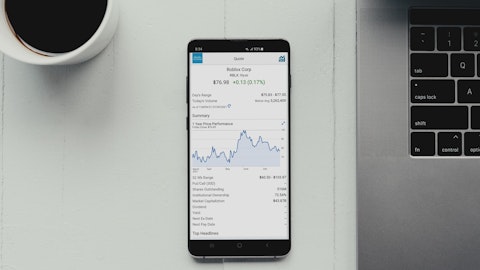Simeon Gutman : Okay. And then my follow-up is a little bit of clarification on the prior question. If you’re buying more inventory, wouldn’t that — that would lower capitalized costs, at least for the first part — in theory, I think if that’s right, that would help your gross margins earlier on. And may be too early for this, but can you give us any type of preview for gross margin broadly next year balancing, the capitalized cost against I don’t know if it’s LIFO or other factors along with your initiatives, the direction for growth. I think you’ve said it should still be up in that direction next year. Just curious if you can comment on that?
Jeff Shepherd: Yes. I mean, certainly, those costs are going to come off the balance sheet over the balance of next year. We think this is going to be a challenging headwind for us as we go into ’23 and try to continue to grow our margins, both the product cost as well as the capitalized costs, whether it’s freight costs being capitalized, whether it’s supply chain costs being capitalized. That will land on the balance sheet with the inventory as we acquire it and will come off over the balance of next year. Again, we think most of this will roll off in the first half of the year. We will give an update on 2023 in terms of how we’re thinking about our margins, but we know that this is going to be a significant headwind as we go into next year.
Operator: Your next question is from the line of Kate McShane with Goldman Sachs.
Unidentified Analyst: This is on for Kate. Just wondering if you can talk about your category management initiative and specifically the removal of these unprofitable discounts. How far along you are moving those discounts? And how much of a headwind it might have been to comps in the quarter?
Tom Greco : Well, we’re really pleased with the progress we’ve made on category management over the last couple of years. It’s the single biggest driver of gross margin. It’s been a huge contributor to the fact that right up until Q3, we had expanded margins overall for nine straight quarters. So the execution of that plan continues. There’s a couple of elements. There’s strategic sourcing. There’s the owned brand penetration, which improved in the quarter. We were up a couple of hundred basis points in terms of our owned brand penetration. . And then on the pricing front, as I mentioned on the previous question, we’re being very surgical in how we act. So we’re able to remove unprofitable discounts where it doesn’t make sense, and we’re able to invest where we need to in order to drive profitable top line growth.
So it’s really leveraging all the tools that we put in place over the past couple of years. This was the single biggest driver of the margin expansion plan that we laid out over the last couple of years, and we’re continuing to execute against it.
Operator: Your next question is from the line of Elizabeth Suzuki with Bank of America. Okay. We will move on to the next question that comes from the line of Steven Zaccone with Citigroup.
Steven Zaccone: A question on the owned brand impact to same-store sales. How do you expect that to trend in the fourth quarter? And should that continue to be a drag into next year? At what point is that kind of in the baseline?
Tom Greco : Sure. Well, we’ve been expanding for several quarters now, as you know. We called out roughly 80 basis points of net sales and 90 of comp sales. And the big categories that are contributing are the ones that we’ve been transitioning, which is engine management and under car. So we still have a ways to go yet in terms of our reaching our goals there. So we would expect that to continue on. But it’s — it’s a comp sales headwind, but it’s a good thing in that we are driving significant improvement in gross margin. And that’s the opportunity for us. I mean, margin expansion remains very, very important to us, and this is a key part of that. The good thing here is our customers love this product. I mean, we’re building strong brands.
is a terrific brand. It had another great quarter. We’re at the #1 highly regarded — most highly regarded battery in the country. We’ve extended that into other categories such as tools. And then the Carquest brand is very popular with professional installers. The quality that we put in place for our Carquest product is very much respected by our customers. We have a much lower return rates. So it’s a very positive story. And we’ll take the comp sales on a long with obviously, the margin expansion that we’re getting from it.
Steven Zaccone : Okay. Then second question, more of a strategic question. So you plan on accelerating growth in 2023 because of the potential share loss you’ve seen. What does that mean for the strategic importance of margin expansion next year? I know you’re not providing guidance, but given your commentary about the difficulty in achieving that margin rate that you previously talked about for 2023, should we be thinking a pause in margin expansion is the right way to think about the model for ’23?
Tom Greco : Sure. Well, let me speak to the targets we talked about. It’s about 18 months ago, if you recall, in April of 2021. And what we did at that point was we outlined three overarching goals to drive total shareholder return: comp sales growth, expand margins and returning excess cash to shareholders. And we also established six financial metrics associated with that TSR drivers. In 2021, we performed really well against the TSR drivers and all six of those metrics we achieved. We ended up in the top quartile in terms of TSR performance relative to the S&P. We’re now — up until now, we had nine straight quarters of sales growth and margin expansion. As we got into 2022, the macroeconomic and competitive environment changed and it really impacted us in the third quarter.
While we expect to expand margins full year this year and we’ve already returned about $900 million in cash to shareholders, our 2022 sales are below our expectations. And we are taking the actions now to address that underperformance. So as we look forward to 2023, to your direct question, we believe we can get inside the ’23 ranges on most of the metrics that we outlined. However, the margin rate and EPS ranges are really dependent on the competitive environment that we’ll see in 2023, which is hard to predict right now. And if the competitive environment, in Professional particularly, looks like it does in 2022, achieving the low end of the range of those two areas, margin rate and earnings per share is unlikely. Now if we look beyond 2023, we’re building a plan that will include all the key elements of the current TSR agenda, and we’re going to continue to target top quartile TSR growth including all of those elements.
So we still have plenty of upside to drive TSR going forward. We’re just being cautious about 2023 given the competitive environment that we’re in right now.





